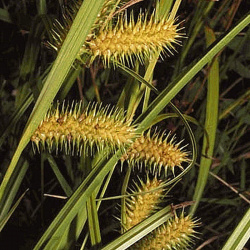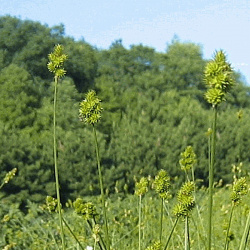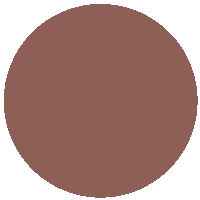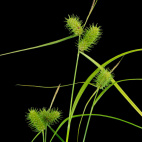Color
Availability
USDA Zone
Region
Type
Duration
Season
Germination
Soil
Sunlight
Height
Narrow Your Search
Color
Availability
USDA Zone
Region
Type
Duration
Season
Germination
Soil
Sunlight
Height
US Native Sedge Seeds
These Sedge grass seeds are an interesting bunch. Most of these come from the genus of Carex and most are cool season type grasses. A lot of sedges are at home in a wetland habitat, but there are some that tolerate mesic soils as well. There are actually hundreds of the Carex family in existence, so this is just a sampling of the unique species to be found in this family. Sedge grasses are almost impossible to identify by their leaves, but identification becomes more apparent when the seed heads appear because they are so unique.
-
 On Sale!
Sallow Sedge Seeds
Carex lurida
This native sedge prefers wet soil to produce it's yellowish spiny seed heads. This native sedge is not as common as some of its cousins but is sometimes used for native wetland restoration projects.Quick Viewx
On Sale!
Sallow Sedge Seeds
Carex lurida
This native sedge prefers wet soil to produce it's yellowish spiny seed heads. This native sedge is not as common as some of its cousins but is sometimes used for native wetland restoration projects.Quick ViewxSallow Sedge Seeds
Carex lurida
This native sedge prefers wet soil to produce it's yellowish spiny seed heads. This native sedge is not as common as some of its cousins but is sometimes used for native wetland restoration projects.
$3.48 Pkt - $16.57 / Oz -
 Spreading Oval Sedge Seeds
Carex normalis
This native sedge can grow in average garden soil, but flourishes in wet fields, and along streams. The oval-shaped seedheads grow on grassy clumps, which spread over time. Like most sedges, this is a cool-season perennial grass.Quick Viewx
Spreading Oval Sedge Seeds
Carex normalis
This native sedge can grow in average garden soil, but flourishes in wet fields, and along streams. The oval-shaped seedheads grow on grassy clumps, which spread over time. Like most sedges, this is a cool-season perennial grass.Quick ViewxSpreading Oval Sedge Seeds
Carex normalis
This native sedge can grow in average garden soil, but flourishes in wet fields, and along streams. The oval-shaped seedheads grow on grassy clumps, which spread over time. Like most sedges, this is a cool-season perennial grass.
$3.48 Pkt - $54.00 / Oz
These Sedge grass seeds are an interesting bunch. Most of these come from the genus of Carex and most are cool season type grasses. A lot of sedges are at home in a wetland habitat, but there are some that tolerate mesic soils as well. There are actually hundreds of the Carex family in existence, so this is just a sampling of the unique species to be found in this family. Sedge grasses are almost impossible to identify by their leaves, but identification becomes more apparent when the seed heads appear because they are so unique.







